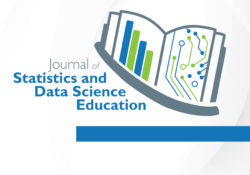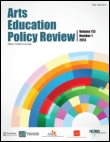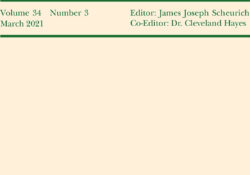tandfonline.com har udgivet en rapport under søgningen “Teacher Education Mathematics”: Abstract Formulae display:?Mathematical formulae have been encoded as MathML and are displayed in this HTML version using MathJax in order to improve their display. Uncheck the box to turn MathJax off. This feature requires Javascript. Click on a formula to zoom. Abstract In the classroom, we traditionally visualize inferential concepts using static graphics or interactive apps. For example, there is a long history of using apps to visualize sampling distributions. The lineup protocol for visual inference is a recent development in statistical graphics that has created an opportunity to build student understanding. Lineups are created by embedding plots of observed data into a field of null (noise) plots. This arrangement facilitates comparison and helps build student intuition about the difference… Continue Reading →
Like this:
Like Loading...
tandfonline.com har udgivet en rapport under søgningen “Teacher Education Mathematics”: ABSTRACT ABSTRACT The study aims for identifying the driving forces that lead German children with VI to switch from mainstream schooling to special schooling. The results are intended to provide more understanding from the perspective of these students about how school settings for students with and without visual impairment can be designed with as few barriers as possible to meet these students’ specific needs. Six female and four male students, who have been schooled inclusively during their school career and then made the decision to be educated in the upper Gymnasium (grammar school) classes at a special school participated in the present study. It is apparent that all of the students had extensive experiences of exclusion in mainstream schooling. The… Continue Reading →
Like this:
Like Loading...
tandfonline.com har udgivet en rapport under søgningen “Teacher Education Mathematics”: Abstract Formulae display:?Mathematical formulae have been encoded as MathML and are displayed in this HTML version using MathJax in order to improve their display. Uncheck the box to turn MathJax off. This feature requires Javascript. Click on a formula to zoom. Abstract It has been asserted that the test-based accountability of No Child Left Behind (NCLB) increased instruction in tested subject areas reading and math, leading to reductions in arts education. We tested this using two waves of data, before and after NCLB implementation, in a difference-in-differences design. The analyses indicated that the total teacher workforce increased substantially during this time period, while the percentage of reading and math educators remained constant, leading to an overall increase in the teacher… Continue Reading →
Like this:
Like Loading...
tandfonline.com har udgivet en rapport under søgningen “Teacher Education Mathematics”: ABSTRACT ABSTRACT This study investigates how different visual representations of price facilitate learning in upper secondary social science education. Three lessons on pricing were given to four classes (n = 94 students). Two classes had lessons based on graphs and two on a causal loop diagram. Written pre- and post-test answers were analysed phenomenographically and results arising from the two visual representations were compared. Results suggested that a causal loop diagram facilitated a more complex way of understanding the causal relationships in pricing than the graph. The traditional way of introducing price, through the use of supply/demand graphs, is thereby problematised. The study extends knowledge by identifying a synergy between phenomenography and research on visual representations and has specific implications for teaching… Continue Reading →
Like this:
Like Loading...
tandfonline.com har udgivet en rapport under søgningen “Teacher Education Mathematics”: Abstract Abstract This article focuses on how the capacity of diffractive readings is put to work in a study of two different types of visual material in research conducted in a preschool. The analysis with the help of –the language of the flat ontology– and the diffractive readings take place in educational research among three-year-olds. Children’s photographs and video recordings produced by the researcher are seen as data that both interfere with and affects the outcome of the study. Diffractive methodologies are used to connect the research and the two kinds of visual data with previous research, some theoretical concepts from Karen Barad’s agential realism and the researcher’s experience of becoming and learning throughout the development of the entangled research… Continue Reading →
Like this:
Like Loading...
eric.ed.gov har udgivet: This article addresses the need for research in the areas of Grade R curriculum and pedagogy, Grade R teacher professional development, and early years mathematics teaching. More specifically, it responds to the need for teacher professional development in Grade R mathematics teaching of the geometric concepts of space and shape. The article describes a study about teachers’ understanding of how visual arts can be used as pedagogical modality. The study was prompted by the findings of a ‘Maths and Science through Arts and Culture Curriculum’ intervention undertaken with Grade R teachers enrolled for a Bachelor of Education (Foundation Phase) degree at a South African university. Post-intervention, teachers’ classroom practices did not change, and they were not using visual arts to teach mathematical concepts. The lessons learned from… Continue Reading →
Like this:
Like Loading...
tandfonline.com har udgivet en rapport under søgningen “Teacher Education Mathematics”: Abstract Abstract The aim of the study was to conduct a systematic review in order to synthesize the evidence-based literature on mathematics education among students with visual impairment (VI). Studies were identified through searches of electronic databases (SCOPUS, PubMed, ERIC, and Web of Science). The authors included articles published between 1 January 2000 and 31 October 2017. Eleven publications met the inclusion criteria, and seven studies had observational designs. The studies focused on teachers’ attitudes and experiences, the use of abacus, tactile graphics, and the development of mathematical concepts. The results showed that the studies had different aims and methods, and only four studies reported eye disorder diagnoses. The ability to choose suitable teaching strategies that involve individual instructions requires… Continue Reading →
Like this:
Like Loading...
tandfonline.com har udgivet en rapport under søgningen “Teacher Education Mathematics”: ABSTRACT ABSTRACT This paper briefly overviews my research in supporting children to learn number concepts by relating number words, research-based visual supports, and math symbols. I first outline my approach to helping children build relationships between the use of concrete materials and the building of abstract concepts. I then focus on two crucial early aspects of building meanings for numbers: (1) understanding break-apart partners such as 5=3+2 that support addition and subtraction with small numbers and children’s moving on to Level 2 counting on and algebraic problem representations, and (2) the use of visual five-groups in understanding numbers 1–1000 and in drawings to support multi-digit computations. The research-based learning path of visual-spatio supports is shown and discussed for each topic,… Continue Reading →
Like this:
Like Loading...
eric.ed.gov har udgivet: Introduction: This article, based on a study of 196 teachers of students with visual impairments, reports on the experiences with and opinions related to their decisions about instructing their students who are blind or have low vision in the abacus. Methods: The participants completed an online survey on how they decide which students should be taught abacus computation skills and which skills they teach. Data were also gathered on those who reported that they did not teach computation with the abacus. Results: The participants resided in the United States and Canada and had various numbers of years of teaching experience. More than two-thirds of those who reported that they taught abacus computation skills indicated that they began instruction when their students were between preschool and the second… Continue Reading →
Like this:
Like Loading...
eric.ed.gov har udgivet: Visual thinking routines are principles based on several theories, approaches, and strategies. Such routines promote thinking skills, call for collaboration and sharing of ideas, and above all, make thinking and learning visible. Visual thinking routines were implemented in the teaching methodology graduate course at the American University in Dubai. The following study used mixed methods. It was guided by two research questions: 1) To what extent did visual thinking routines implemented in the Math/Science methodology course offered at the Graduate School of Education at the American University in Dubai inspire learning in the classroom and made time for students’ questions, contributions, and thinking? 2) How do visual thinking routines inspire learning in the classroom and make time for students’ questions, contributions, and thinking? Eight student teachers enrolled… Continue Reading →
Like this:
Like Loading...






